No CrossRef data available.
Article contents
Congruent elliptic curves and the  $\tau $-component in the Iwasawa main conjecture
$\tau $-component in the Iwasawa main conjecture
Part of:
Algebraic number theory: global fields
Arithmetic algebraic geometry
Discontinuous groups and automorphic forms
Published online by Cambridge University Press: 29 May 2025
Abstract
Let p be an odd prime, and suppose that  $E_1$ and
$E_1$ and  $E_2$ are two elliptic curves which are congruent modulo p. Fix an Artin representation
$E_2$ are two elliptic curves which are congruent modulo p. Fix an Artin representation  $\tau\,{:}\,G_{F}\rightarrow \mathrm{GL}_2(\mathbb{C})$ over a totally real field F, induced from a Hecke character over a CM-extension
$\tau\,{:}\,G_{F}\rightarrow \mathrm{GL}_2(\mathbb{C})$ over a totally real field F, induced from a Hecke character over a CM-extension  $K/F$. Assuming
$K/F$. Assuming  $E_1$ and
$E_1$ and  $E_2$ are ordinary at p, we compute the variation in the
$E_2$ are ordinary at p, we compute the variation in the  $\mu$- and
$\mu$- and  $\lambda$-invariants for the
$\lambda$-invariants for the  $\tau$-part of the Iwasawa Main Conjecture, as one switches from
$\tau$-part of the Iwasawa Main Conjecture, as one switches from  $E_1$ to
$E_1$ to  $E_2$. Provided an Euler system exists, it will follow directly that IMC
$E_2$. Provided an Euler system exists, it will follow directly that IMC $(E_1,\tau)$ is true if and only if IMC
$(E_1,\tau)$ is true if and only if IMC $(E_2,\tau)$ is true.
$(E_2,\tau)$ is true.
MSC classification
Information
- Type
- Research Article
- Information
- Mathematical Proceedings of the Cambridge Philosophical Society , Volume 179 , Issue 2 , September 2025 , pp. 373 - 408
- Copyright
- © The Author(s), 2025. Published by Cambridge University Press on behalf of Cambridge Philosophical Society
References
Bosma, W., Cannon, J. and Playoust, C.. The MAGMA Computer Algebra System, version 2.27-8, (University of Sydney, 1997).Google Scholar
Castella, F., Kim, C.-H. and Longo, M., Variation of anticyclotomic Iwasawa invariants in Hida families. Algebra Number Theory 11 (2017), 2339–2368.CrossRefGoogle Scholar
Choi, S. H. and Kim, B. D., Congruences of two-variable p-adic L-functions of congruent modular forms of different weights, The Ramanujan Journal 43 (2017), 163–195.10.1007/s11139-016-9819-8CrossRefGoogle Scholar
Corbett, A. and Saha, A., On the order of vanishing of newforms at cusps, Math. Res. Let. 25 (2018), 1771–1804.CrossRefGoogle Scholar
Corpuz, R.. Iwasawa theory for tensor products of Hilbert modular forms. PhD. thesis. University of Waikato (2025).Google Scholar
Delbourgo, D., Exceptional zeroes of p-adic L-functions over non-abelian field extensions, Glasg. Math. J. 58 (2016), 385–432.CrossRefGoogle Scholar
Delbourgo, D., Variation of the analytic
 $\lambda$
-invariant over a solvable extension, Proc. London Math. Soc. 120 (2020), 918–960.CrossRefGoogle Scholar
$\lambda$
-invariant over a solvable extension, Proc. London Math. Soc. 120 (2020), 918–960.CrossRefGoogle Scholar
Delbourgo, D., Variation of the algebraic
 $\lambda$
-invariant over a solvable extension, Math. Proc. Camb. Phil. Soc, 170 (2021), 499–521.10.1017/S0305004119000495CrossRefGoogle Scholar
$\lambda$
-invariant over a solvable extension, Math. Proc. Camb. Phil. Soc, 170 (2021), 499–521.10.1017/S0305004119000495CrossRefGoogle Scholar
Delbourgo, D., On the Iwasawa
 $\mu$
-invariant and
$\mu$
-invariant and
 $\lambda$
-invariant associated to tensor products of newforms, Ann. Inst. Fourier 74 (2024), 451–502.CrossRefGoogle Scholar
$\lambda$
-invariant associated to tensor products of newforms, Ann. Inst. Fourier 74 (2024), 451–502.CrossRefGoogle Scholar
Delbourgo, D. and Lei, A., Heegner cycles and congruences between anticyclotomic p-adic L-functions over CM-extensions, New York J. Math. 26 (2020), 496–525.Google Scholar
Dimitrov, M., Galois representations modulo p and cohomology of Hilbert modular varieties, Ann. Sci. École Norm. Sup. 38 (2005), 505–551.CrossRefGoogle Scholar
Dimitrov, M., On Ihara’s lemma for Hilbert modular varieties, Compositio Math. 145 (2009), 1114–1146.CrossRefGoogle Scholar
Dokchitser, T. and Dokchitser, V., Computations in non-commutative Iwasawa theory, Proc. London Math. Soc. 94 (2007), p 211–272.10.1112/plms/pdl014CrossRefGoogle Scholar
Emerton, M., Pollack, R. and Weston, T., Variation of Iwasawa invariants in Hida families, Invent. Math. 163 (2006), 523–580.10.1007/s00222-005-0467-7CrossRefGoogle Scholar
Gouvêa, F., Deforming Galois representations: controlling the conductor, J. Number Theory 34 (1990), 95–113.10.1016/0022-314X(90)90055-VCrossRefGoogle Scholar
Greenberg, R., Iwasawa theory for elliptic curves, In Arithmetic Theory of Elliptic Curves, Cetraro. 1997, Lecture Notes in Math. 1716 (1997), 51–144.10.1007/BFb0093453CrossRefGoogle Scholar
Greenberg, R. and Vatsal, V., On the Iwasawa invariants of elliptic curves, Invent. Math. 142 (2000), 17–63.10.1007/s002220000080CrossRefGoogle Scholar
Hida, H., On p-adic L-functions of GL(2)
 $\times$
GL(2) over totally real fields, Ann. Inst. Fourier 41 (1991), 311–391.10.5802/aif.1258CrossRefGoogle Scholar
$\times$
GL(2) over totally real fields, Ann. Inst. Fourier 41 (1991), 311–391.10.5802/aif.1258CrossRefGoogle Scholar
Hida, H., On the critical values of L-functions of
 $\mathrm{GL}(2)$
and
$\mathrm{GL}(2)$
and
 $\mathrm{GL}(2)\times \mathrm{GL}(2)$
. D. Math. J. 74 (1994), 431–529.Google Scholar
$\mathrm{GL}(2)\times \mathrm{GL}(2)$
. D. Math. J. 74 (1994), 431–529.Google Scholar
Khare, C. and Wintenberger, J.-P., Serre’s modularity conjecture I, Invent. Math. 178 (2009), 485–504.10.1007/s00222-009-0205-7CrossRefGoogle Scholar
Lei, A., Loeffler, D. and Zerbes, S., Euler systems for Rankin-Selberg convolutions of modular forms, Ann. of Math. 180 (2014), 653–771.10.4007/annals.2014.180.2.6CrossRefGoogle Scholar
Livné, R.. On the conductors of mod l Galois representations coming from modular forms, J. of Number Theory 31 (1989), 133–141.10.1016/0022-314X(89)90015-2CrossRefGoogle Scholar
Kings, G., Loeffler, D. and Zerbes, S.. Rankin-Eisenstein classes and explicit reciprocity laws, Cambridge J. Math. 5 (2017), 1–122.10.4310/CJM.2017.v5.n1.a1CrossRefGoogle Scholar
Maletto, S.. An integral two variable
 $p$
-adic
$p$
-adic
 $L$
-function for the
$L$
-function for the
 $\chi$
-twisted symmetric square representation associated to an ordinary modular form. PhD. thesis. University of British Columbia (2025).Google Scholar
$\chi$
-twisted symmetric square representation associated to an ordinary modular form. PhD. thesis. University of British Columbia (2025).Google Scholar
Manning, J. and Shotton, J., Ihara’s Lemma for Shimura curves over totally real fields via patching, Math. Ann. 379 (2021), 187–234.10.1007/s00208-020-02048-8CrossRefGoogle Scholar
Panchishkin, A., Non-archimedean L-functions of Siegel and Hilbert modular forms. Lecture Notes in Math. 1471 (Springer-Verlag, 1991).10.1007/978-3-662-21541-8CrossRefGoogle Scholar
Ray, A., Sujatha, R. and Vatsal, V., Iwasawa invariants for symmetric square representations, Res. Math. Sci. 10 (27) (2023).CrossRefGoogle Scholar
Shemanske, T. and Walling, L., Twists of Hilbert modular forms, Trans. Amer. Math. Soc. 338 (1993), 375–403.10.1090/S0002-9947-1993-1102225-XCrossRefGoogle Scholar
Shimura, G., Special values of the zeta-functions associated with Hilbert modular forms, Duke Math. J. 45 (1978), 637–679.10.1215/S0012-7094-78-04529-5CrossRefGoogle Scholar
Taguchi, Y., Induction formula for the Artin conductors of mod l Galois representations, Proc. Amer. Math. Soc. 130 (2002), 2865–2869.10.1090/S0002-9939-02-06524-3CrossRefGoogle Scholar

